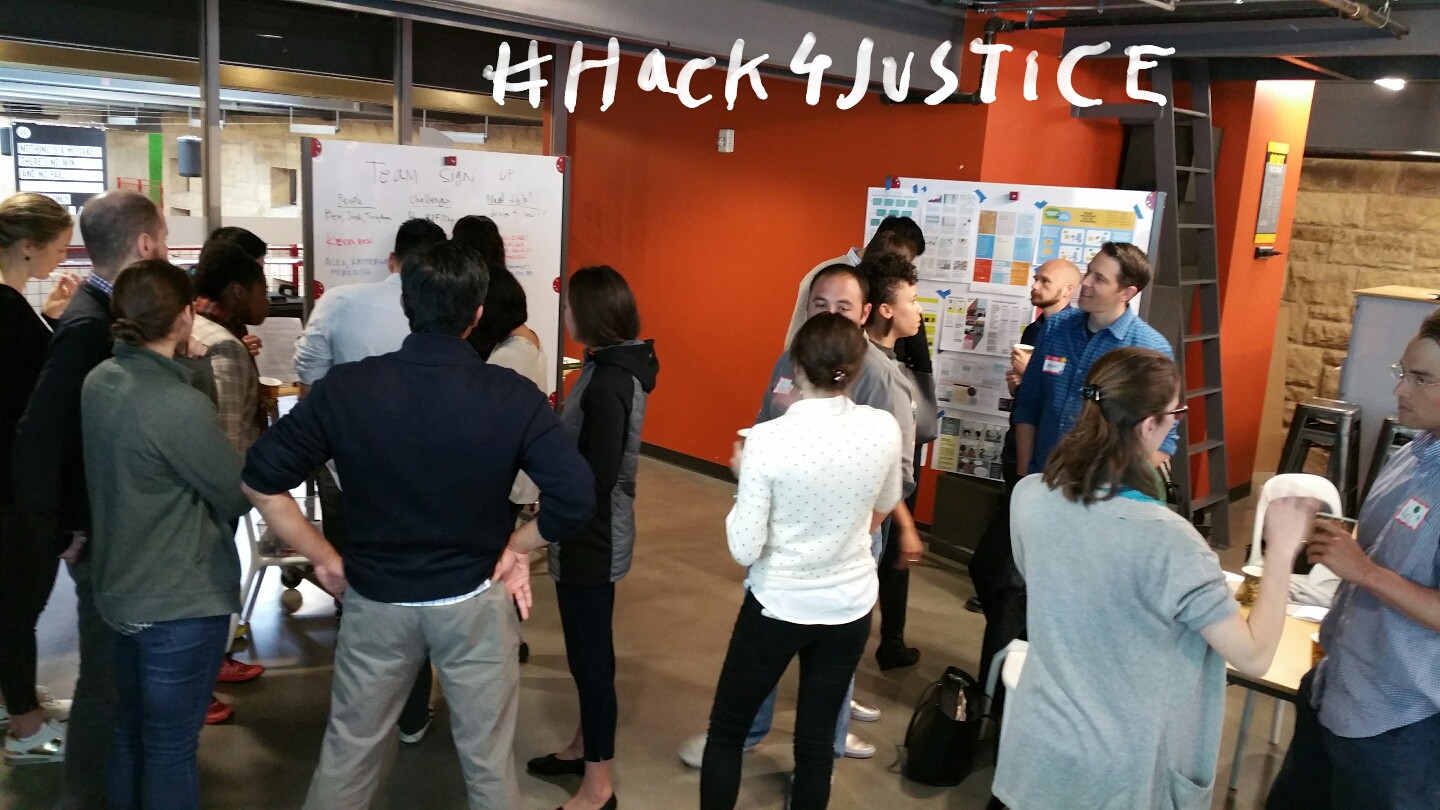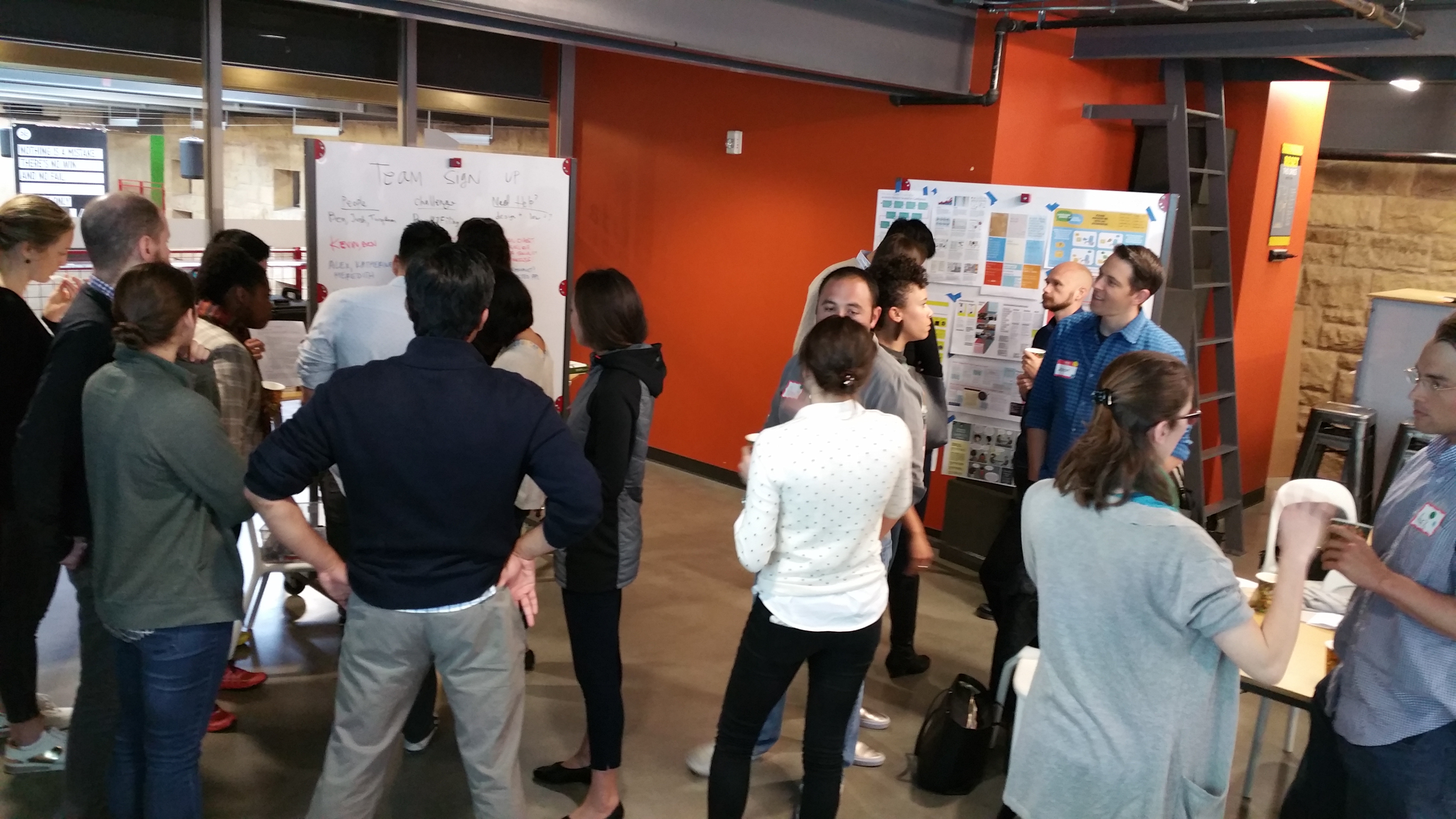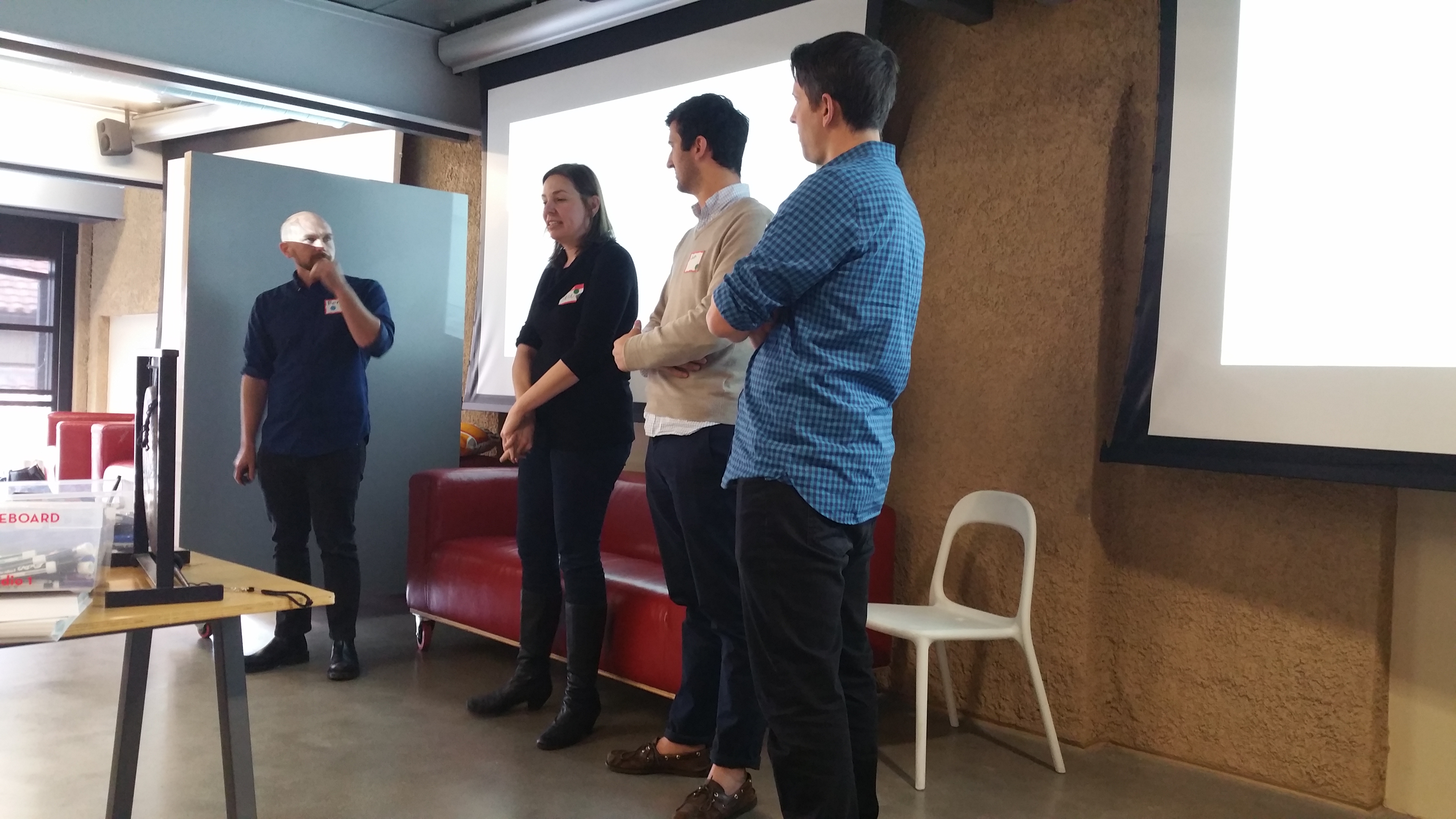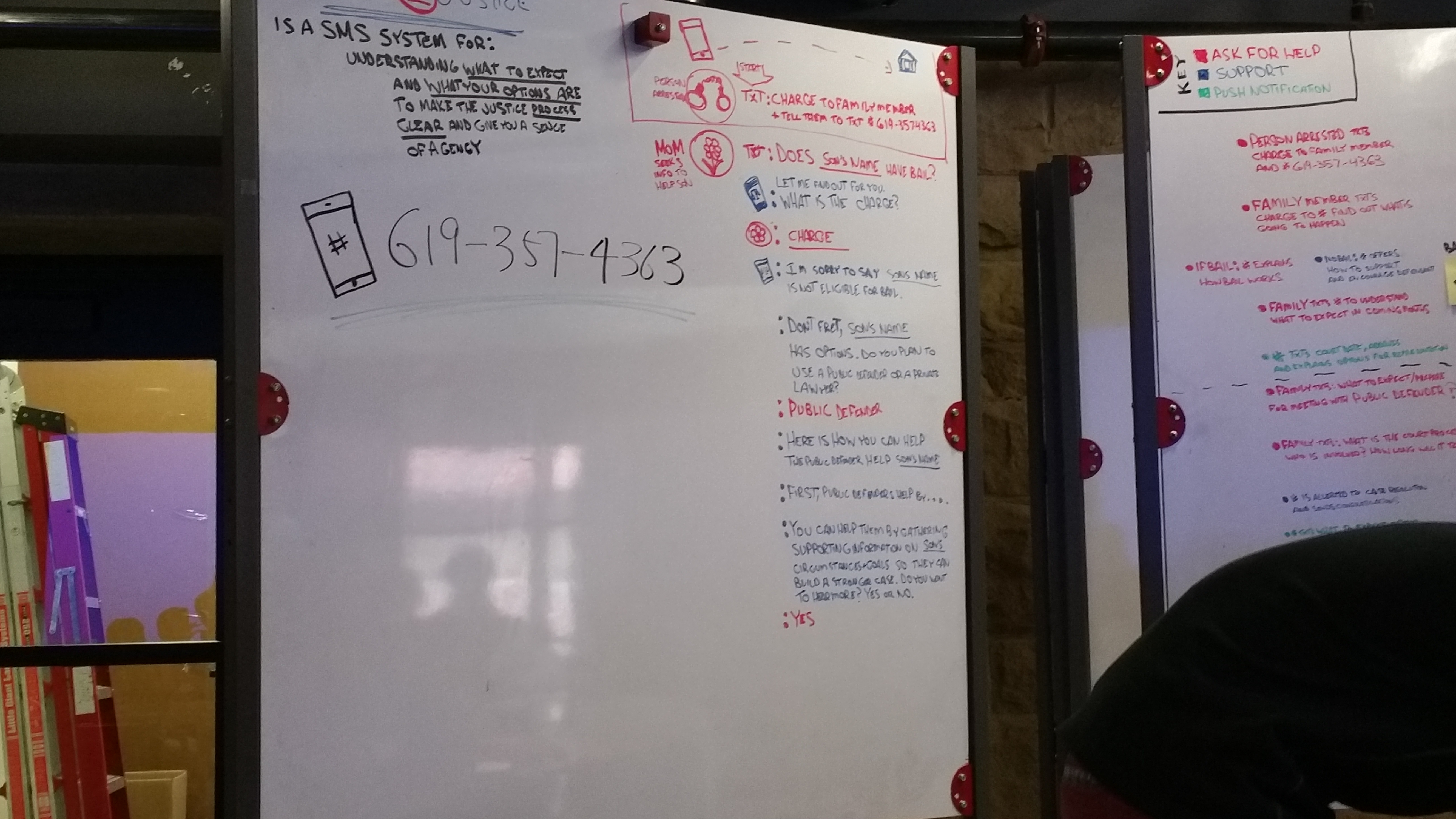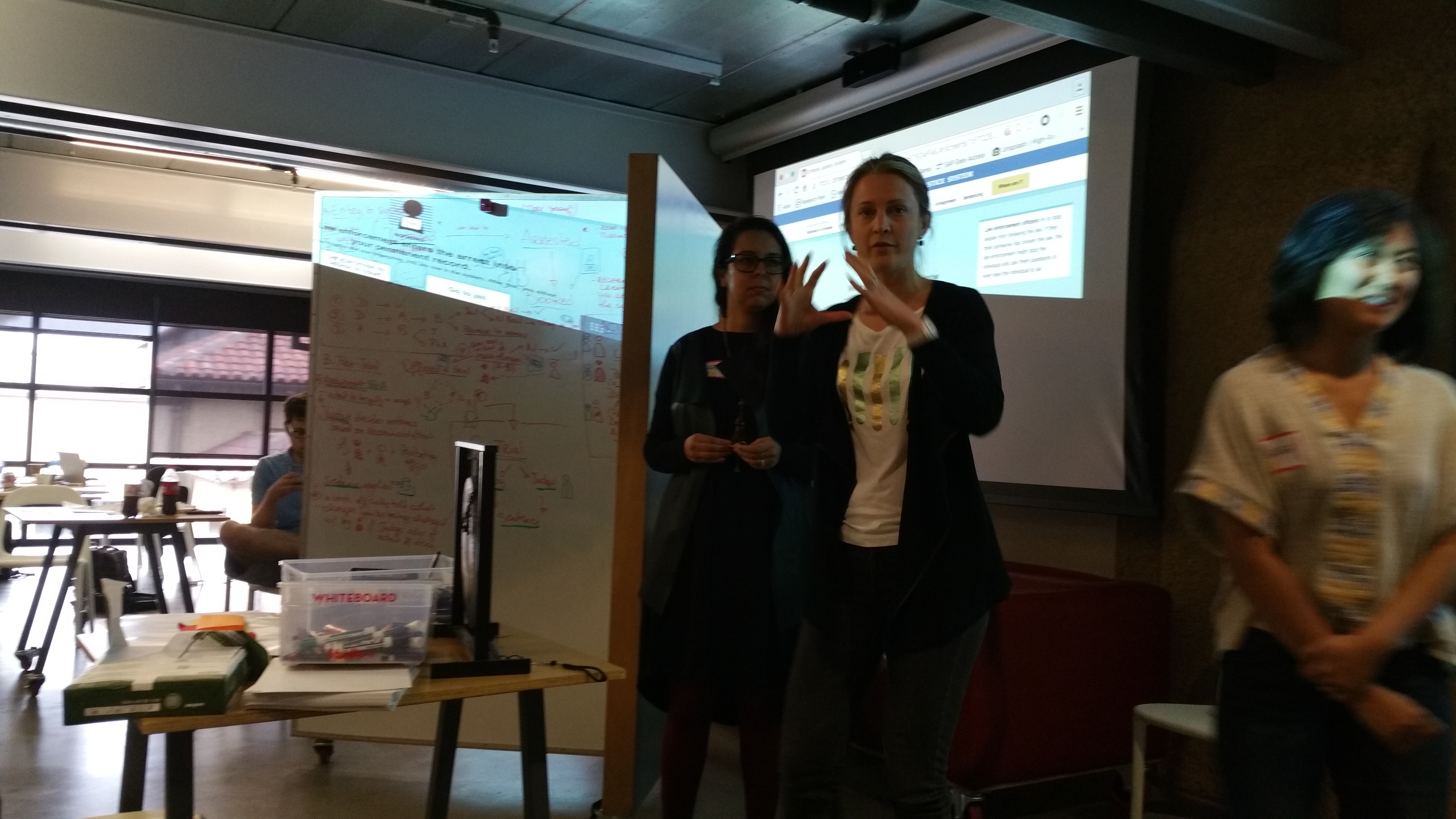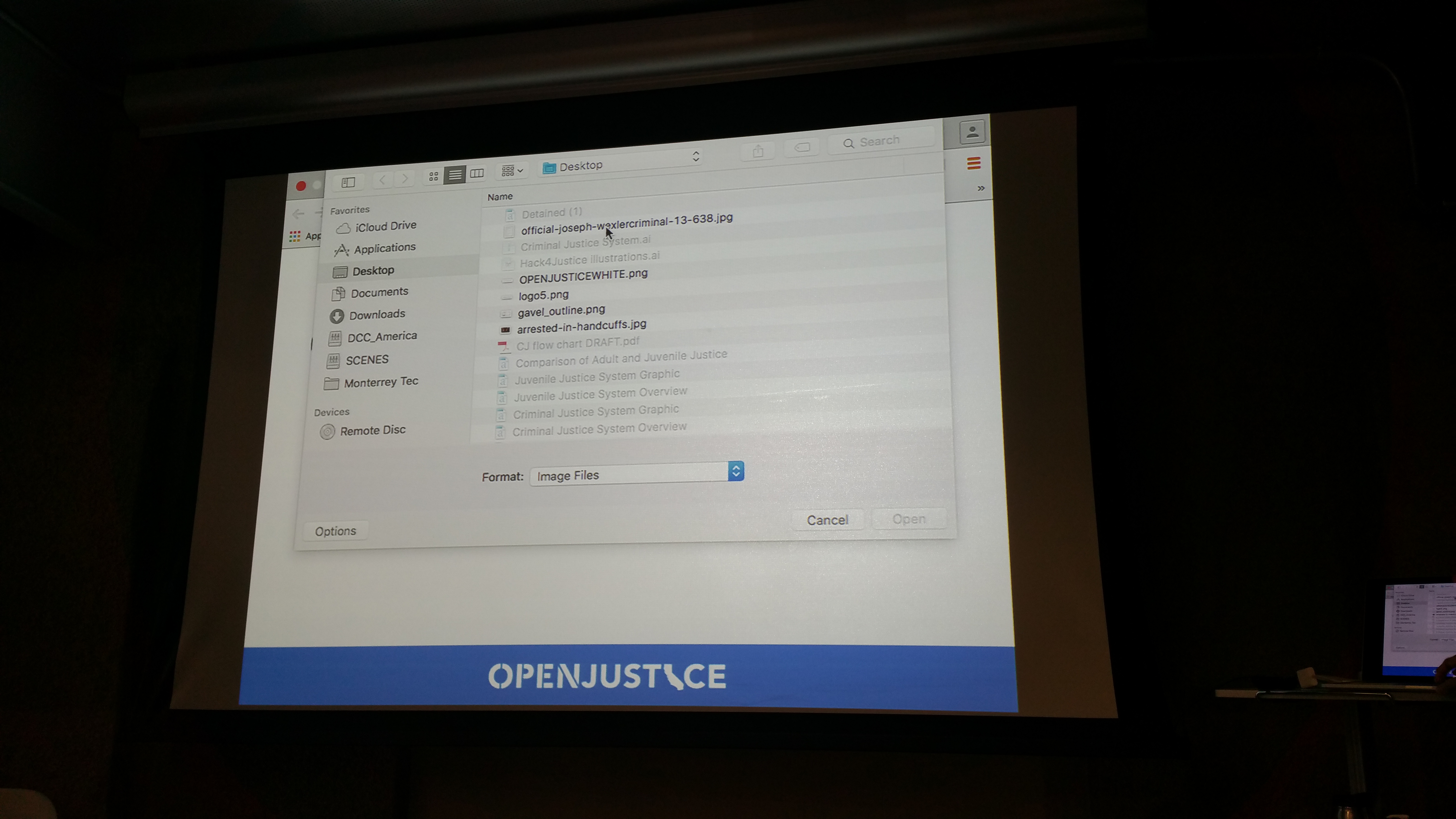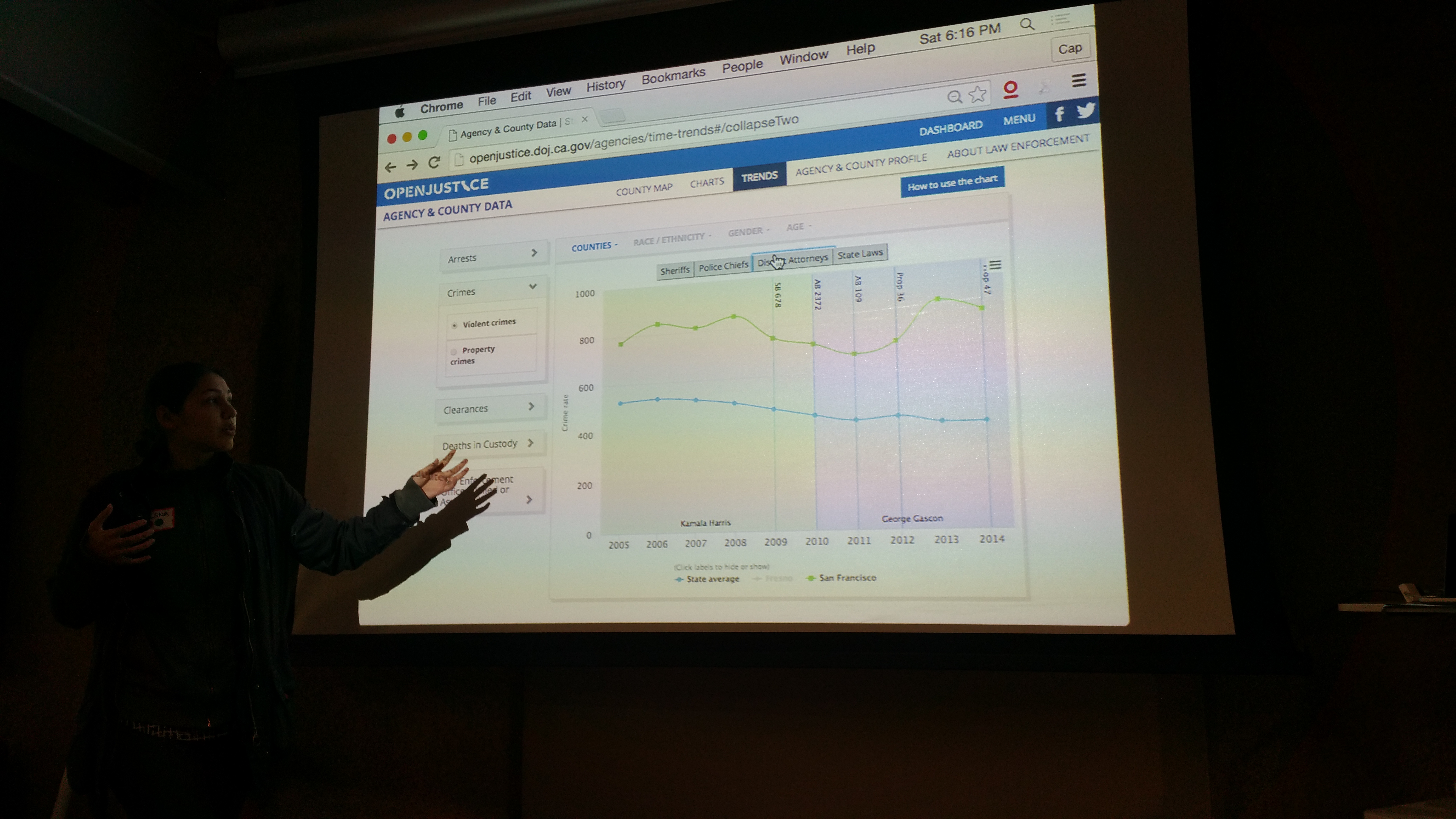We had an amazing turnout, with a very healthy mix of designers, technologists, policy-makers, and lawyers come together on a grey Saturday morning,
What we did
The day was loosely structured. At the top, we had informal presentations from the DOJ about their OpenJustice platform, their mission to make data more user-friendly and more accessible, and their hopes for the day’s work. There were two challenges they posed to the group:
- Visualizing the Criminal Justice System and its Jargon: The goal here is to develop media, tools, and other things to help people understand the system, its processes, and its jargon. Aimed more for people who are either going through the system now, or who are their family/advocates. It could also be a civic education tool, to help students, members of the public, and even journalists literate in how this very confusing system operates.
- Making Criminal Justice Data come alive: How can we make all the data that the DOJ gathers about the justice system in California be more useful and engaging? Are there other displays, data sets, interactive features, or beyond that could make this data more meaningful? The target users here are researchers, journalists, policy-makers, and engaged citizens who want to understand the realities of how the justice system is operating, and to figure out better ways to intervene and improve it. (As well as, even, what better questions we can be asking about the system — where to be looking to find sparks for new solutions).
Our Working Session
Most of the day was spent in small groups, developing out possible use cases for visual guides and data visualizations, and then creating initial demo’s of these new initiatives.
We the organizers let the groups choose themselves. Most people didn’t know each other before, so we asked them to tag their name-badge with small colored stickers that would indicate their skillsets — tech, design, policy, and law. We only laid down the rule: no more than five people per team, and try to get a healthy mix of colors (skills) on your team.
Everyone mixed and after 10 minutes, signed up for what team they’d work on, which of the two challenges they’d tackle, and what use cases or topics they would start off with.
For the next five hours, the groups worked together to put a proposal and a working demo together for a new tool, site, or service for consideration by the DOJ and the rest of the group. As the organizers, we floated and brought in some coaches and mentors to help out, if any teams needed legal, tech, or data help. But largely we tried to stay out of the groups’ way — the magic was in seeing them come together, figure out something specific to solve for, and then bring their own different knowledge and skills to designing a better way of doing things.
The Concepts and Demo’s
The Prop 47 Filing Tool came from an existing Code for America project, Clean My Record, but builds in more functionality for Californians who want to get their past convictions for select drug crimes to be reduced from felonies down to misdemeanors. The tool is not do-it-yourself, because, from experience of law students and lawyers on the team, it’s actually quite hard for a lay person to figure out what they’re eligible for and to determine which course best suits their preferences.
The team was Ben Chida, Josh Steele, Tara Lundstrom, and Aaron Stienstra.
The tool has two user streams: the person considering applying, who can enter (on a very simple mobile-friendly interface) the basics of their case information. Then there is the lawyer/advocate, who can screen this person’s information, prep what options and questions arise out of this intake information, and then do a real phone call to them, to talk through the options and get decisions made. Then the lawyer/advocate can follow through on the application and continue the communication through text, email, or phone.
The goal here is not to eliminate the lawyer step — the group knew from experience that people need the conversation and lawyer’s perspective. But it’s to streamline intake, structure the lawyer’s thinking and conversation, and to automate/easily populate the forms to save the lawyer time.
Chat for Justice is an SMS-based service aimed at people like moms, wives, and other advocates for people who have been arrested and are now in the criminal justice system. The service would provide quick, responsive mobile messages to these family members and advocates, to help them understand what is happening to their loved one in jail, and to give them actionable items to do to help them out.
The team behind it is Kevin Xu, of Stanford Law School, and Ben Peterson, of Code for America in Salt Lake City.
One version of this tool is personalized with the person’s case information. This would be an ideal version, if the justice system would allow for use of the data — about the person’s charges, location, bail, and other details. This would let the advocate on the outside start coordinating a strategic plan: how can I raise bail, how much do I need to raise, where can I see my loved one, how can I get a lawyer or other support to help deal with the coming prosecution?
Another variation, that is likely easier to deploy sooner (because it doesn’t require the system to provide case data), is a generalized stream of information and strategic tips about the criminal justice system. It’s for a similar user and use case, but provides them more general educational resources and links. What does misdemeanor vs. felony mean? How does bail work? Will you get a free lawyer, and how does that work? What are the next stages coming up?
Both of these types of chat services would be conversational, quick, and supportive for a person who is suddenly in crisis mode, trying to figure out ways to help their loved one from the outside.
Additionally, this tool could help coordinate the family advocate and the Public Defender. The family advocate could figure out how to be collecting information about their loved one’s personal life, charges, etc. that they could then supply to the PD in order to help humanize the person, give relevant information to be used in the case, and help the PD get a jump on their own work.
Re-entry Assistance is a web app that helps a person who’s come out of prison/jail to go to a centralized site, see the menu of services that they might need (legal, disability, medical, social, mental health, etc.) and a map of local service-providers they could connect with.
The team here was Alex Entrekin, Katherine Nammacher, and Meredith Hitchcock.
It came out of the use case of one of the participants — a lawyer who works in a Santa Barbara legal clinic, who has people who come out of prison/jail show up at the clinic looking for them to help with all kinds of issues and needs. The clinic can’t provide this coordinated suite of services. But it wants to provide some links, resources, and warm hand-offs that can start moving to this ‘concierge’ version of service. Because otherwise people end up bouncing around all kinds of agencies, chasing dead-ends, and getting dispirited (if not giving up on finding services all together).
This idea links into Sacha Steinberger’s wonderful Project Legal Link, which similarly aims towards coordinating social and legal service providers. Hopefully they might be able to converge — there is clearly a strong need, and tech could provide much of this coordination.
Visual Guide to the Justice System was made in direct response to Challenge #1 — and it’s a web-based visual guide to the stages that a person goes through if they are arrested and charged with a crime.
The team here was Kyanna Williams, Amit Kumar, Sarah Fathallah, Melissa Acosta, Tim Wang, and Viveca Fallenius.
The team worked hard to make this very confusing and multi-track process more linear, more visual, and easier to intake. They used clean colors, bold icons, and small interactions to help take a person step by step through the stages. They built in more details — definitions, differentiation of different roles/government agents, notes and tips — into sidebars or tooltips.
This site is meant to be a general reference, that can be used in civic education, or as a guide for other tools (like Chat for Justice or the Mobile Document reader) to refer back to.
Mobile Document Guide was built by Amit Kumar– as he worked with the Visual Process team above, and found a new tool he could be building.
If you get a letter from the justice system in the mail, this tool would let you take a photo of it on your mobile phone, and then it would OCR the text, analyze what the procedure and details of it are, and then give you resources and links to understand what’s going on and what you should be doing.
For example, if this letter came in the mail — the app would tell you what to do in response. It would pull out key phrases and action points, and direct you to resources for this specific action.
Here’s a demo that participant Amit Kumar built.
Deepeterizer: bringing context into data visualizations. This project came from the idea of ‘how can I understand charts and maps, if it’s just a lot of data-points?’ So, the team developed new ways of displaying context directly onto the charts and graphs.
For example, instead of just seeing the line graphs of arrests or charges, you can see this same graph with some new data points displayed as background colors or lines on top of the graph. Like, who was the attorney general or sheriff at the time. Or, what laws were passed and implemented. These contextual points can help reveal why the data changes, and what underlying dynamics might be.
This tool was from the team of Selena Teji, Cap Petschulat, and Peter Borenstein.
Final Thoughts
We at the Legal Design Lab and the California Department of Justice were deeply impressed by the level of work and commitment by all the participants. We were together from 10:30-6:30pm on a Saturday, and we came up with a great set of new resources and tools for people to use as they are navigating the criminal justice system — as well as some new teams and partnerships of professionals who don’t often get the chance to come together.
The DOJ’s team will be in touch with the projects around data visualization and visualizing the justice system, and at the Legal Design Lab we will be supporting the teams who are building new coordinated services and tools. Our goal is to build from the great momentum and creativity that came out from Hack for Justice, and now spend the time to test, refine, and launch these tools to serve the public, and make the system work better.
Please be in touch if you are interested in the projects, or have ideas about how best to implement or situate them.
Thanks once again to all the participants!
